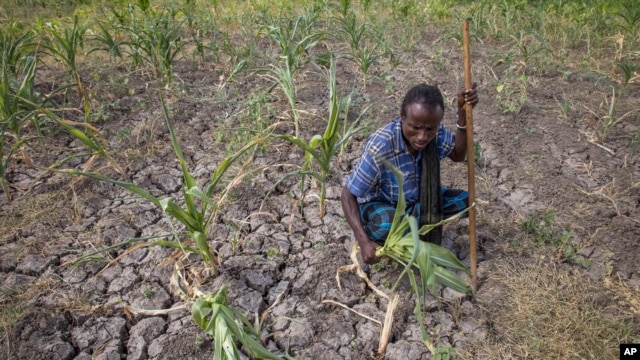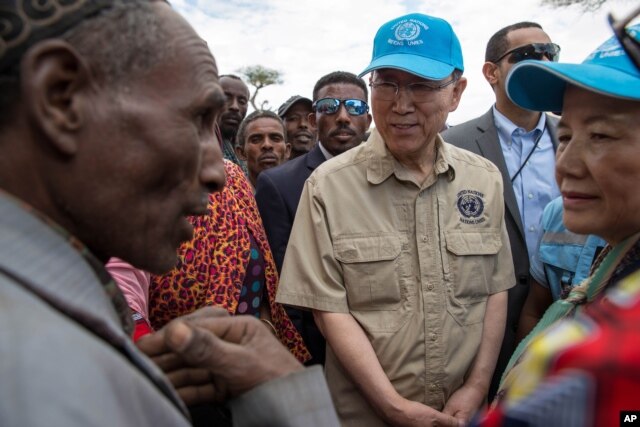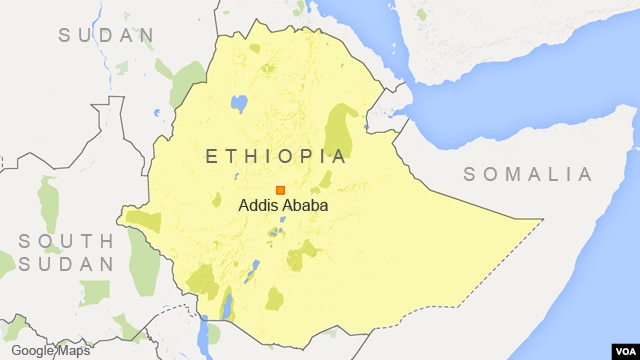Date: Tue, 1 Mar 2016 12:48:48 +0100
FILE - A farmer shows his failed crops and farmland in the Megenta area of Afar, Ethiopia, Jan.26, 2016.
March 01, 2016 10:00 PM
When drought and pests decimated their farm in Ethiopia's northern Amhara region, 10-year-old Eseye Tiruneh and her family boarded a bus, fleeing the starvation all around them.
It was 1985 and Ethiopia was in the grip of its worst famine, which killed around one million people.
Ethiopia's communist regime resettled Eseye's family in Wollega, over 1,000 km (620 miles) southwest, as part of an ambitious plan to move more than a million people from the drought-affected north, where it was fighting a rebellion, to the fertile west.
But they did not escape death.
Eseye's mother, grandmother and two siblings died in an epidemic of malaria and diarrhea that killed about a dozen people each day in the resettlement village.
"It was only my father and I who survived," said Eseye, now aged 40, wearing a black headscarf, dusty maroon dress and faded beige shawl, her eyes fixed on her feet. "The main work of the farmers was to bury people."
While no one is predicting famine in Amhara this year, drought is once again casting a shadow over farmers eking out a living on these rocky hillsides.
Precarious
Under a burning sun, hundreds of men and women squatted in the dust outside a warehouse, waiting to fill their plastic bottles with cooking oil and their white sacks with wheat and yellow split peas.
Life is always precarious for families in these densely-populated highlands, who plough narrow terraces cut into steep mountainsides.
The poorest 10 percent receive food aid from the government from January to June every year, in exchange for digging ponds or planting trees.
It started distributing emergency food aid in October after the strongest El Nino on record triggered a drought which left wheat shoots to wither in the fields.
The government and aid agencies have asked for $1.4 billion to feed 10.2 million people — the third-largest appeal globally after Syria and Yemen.
All of the farmers at the food distribution center who remembered the 1984-85 famine said the current drought is worse, particularly as it came on the back of a poor harvest in 2014.
"We are hungry, the children are hungry," said Ayalew Berihun, 51, a blue headscarf wound round his head and a plastic sack stuffed into the pocket of his faded turquoise jacket. "On good days, we usually eat in the morning and evening. But now it is difficult to even eat once a day."
His family of eight did not harvest anything in 2015 from their half hectare plot.
Every few days, they make a three-hour round trip to fetch water from a spring with their donkey.
Up to 30 people can be in the line ahead of them, quickly washing their faces before filling their jerrycans with water that will be reserved for drinking and cooking at home.
But help is at hand this time, unlike in 1984, when the government hid the hunger crisis until it had celebrated its 10th anniversary in power, bombed markets in rebel-held territory and blocked relief to areas controlled by insurgents.
Children drop out of school
Yet with soaring rates of malnutrition, children are dropping out of school and into menial jobs to survive, robbing parents like Eseye and Ayalew of hope for the future.
"I wish God would give us rain so that I can educate my children properly and they could get government jobs, live a better life and support me," said Eseye, who has a cross tattooed on her forehead and a picture of the Virgin Mary on a black string around her neck.
Chances of that are slim. Eseye's daughter quit school at 16 to work in a nearby town so she can send a couple of dollars home to her mother each month.
Eseye's 12-year-old son is still in school, but his attention is waning as his body grows thinner.
"He is getting weak and tired," she said. "He doesn't follow his lessons properly and he doesn't study."
Some 1.3 million schoolchildren have been affected by the drought, the government says, either too hungry to concentrate or dropping out to search for food or water.
In Eseye's village, children aged 12 and above have left home to work as shepherds, housemaids, dish washers and porters while the younger ones are sick with coughs and diarrhea.
"They try to help their younger siblings not die from hunger by sending some money back home," she said.
Then and now
Hunger has not yet brought death in the farming highlands, people said, unlike in 1984 when Derg junta forces and rebels battled on the spectacular mountain paths.
Hundreds of thousands walked along hairpin bend roads from rebel-held Sekota to government-controlled Korem to get help.
"We called it the road of death," said John Graham, country director for Save the Children, who was a young aid worker at the time. "It could have been 100,000 people or more who died just along that road."
Today, Korem is a bustling town, surrounded by fields that turned green after a few days of unseasonal rain in December.
Blue and white tuk tuks vied with donkeys for space on its busy roads, lined with buildings under construction.
"I can't stress enough the difference in the situation between 1985 and 2015," said Graham.
"It was already a full-blown disaster by the time Michael Buerk [of the BBC] got to a Save the Children feeding camp in Korem and announced to the world that this thing was happening."
In contrast, the current government — which ousted the Derg in 1991 and took power — has been quick to acknowledge the crisis and has put $380 million of its own money into the emergency response since July.
"Twenty years ago, we had no such capacity," said Mitiku Kassa, head of Ethiopia's National Disaster Prevention and Preparedness Committee. "It has come through the economic development that we registered for the last 12 years."
Vision
Double-digit growth over the last decade has helped Ethiopia to achieve many of the Millennium Development Goals, slashing poverty, hunger and child mortality rates.
It has a strong, if authoritarian, vision and is keen to dispel the proud nation's image as a poster child for famine.
There is a well-established health system with staff in each local clinic routinely screening children for malnutrition.
Moderate cases receive a fortified porridge and severe ones get therapeutic food, with admission to a stabilization center if there are complications.
"This is not some independent, international relief effort," said Paul Handley, head of the United Nations Office for the Coordination of Humanitarian Affairs in Ethiopia. "This is being done not just together with but actually through government systems."
But eight out of 10 Ethiopians are still dependent on rain-fed agriculture, leaving Africa's second most populous nation vulnerable to drought.
"If the rain doesn't come and this support doesn't come regularly, what is going to happen to us?" asked Ayalew. "I am scared for our lives."



